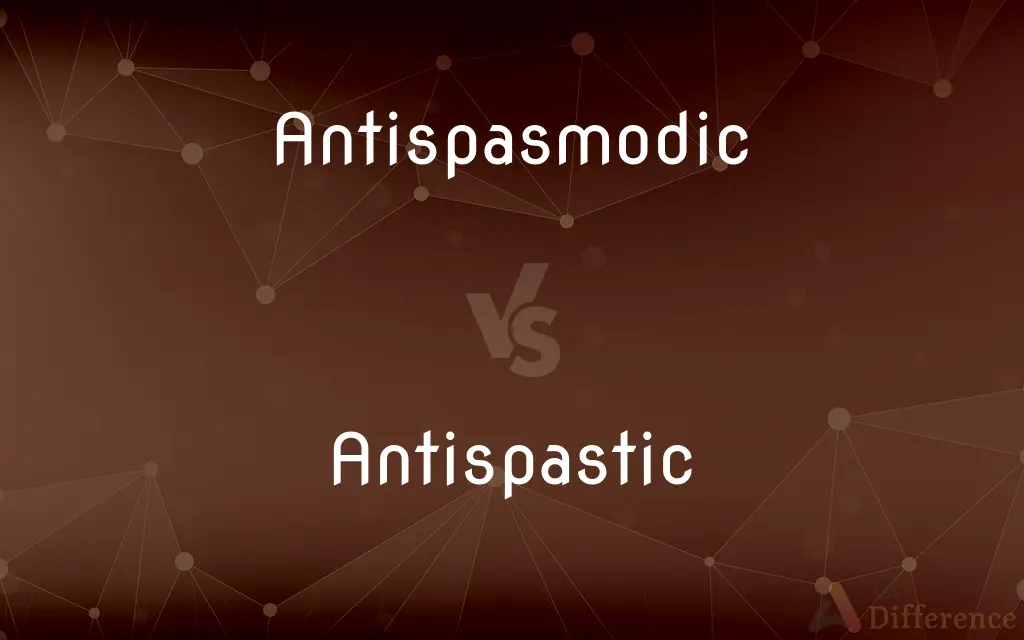Antispasmodic vs. Antispastic — What's the Difference?
Edited by Tayyaba Rehman — By Maham Liaqat — Updated on April 7, 2024
Antispasmodics alleviate muscle spasms, whereas antispastics target spasticity, a specific type of muscle stiffness.

Difference Between Antispasmodic and Antispastic
Table of Contents
ADVERTISEMENT
Key Differences
Antispasmodic agents are primarily used to relieve muscle spasms, which are sudden, involuntary muscle contractions. These spasms can be painful and are often a response to various medical conditions, including gastrointestinal disorders. On the other hand, antispastic agents are prescribed to manage spasticity. Spasticity is characterized by an abnormal increase in muscle tone or stiffness, which can interfere with movement, speech, and gait. This condition is commonly associated with neurological disorders such as multiple sclerosis, cerebral palsy, and spinal cord injury.
Antispasmodics work by relaxing the muscles, thereby reducing the discomfort associated with spasms. Antispastics help by decreasing muscle stiffness, improving mobility and function.
While antispasmodics and antispastics both target muscle-related disorders, their mechanisms of action differ. Antispasmodics usually act on the smooth muscles of the gastrointestinal tract, urinary tract, and other internal organs, often through the inhibition of acetylcholine, a neurotransmitter that mediates muscle contraction. In contrast, antispastics act on the central nervous system to reduce the excessive muscle tone. They often work by enhancing the inhibitory processes or reducing the excitatory transmissions within the brain or spinal cord, which helps in managing the symptoms of spasticity.
The use of antispasmodics is often recommended for temporary relief of muscle spasms, such as those associated with irritable bowel syndrome (IBS) or bladder spasms. These medications can provide significant relief from pain and discomfort without directly impacting muscle tone or strength. Antispastics, however, are used in a broader management plan for individuals with chronic conditions causing spasticity. Treatment with antispastic agents can be crucial for improving the quality of life, enabling better participation in physical therapy, and enhancing overall mobility and independence.
Comparison Chart
Primary Use
Relieving muscle spasms
Managing spasticity
ADVERTISEMENT
Mechanism of Action
Acts on smooth muscles by inhibiting neurotransmitters like acetylcholine
Acts on the central nervous system to adjust muscle tone
Common Conditions Treated
Irritable Bowel Syndrome (IBS), bladder spasms
Multiple sclerosis, cerebral palsy, spinal cord injury
Effect on Muscles
Reduces involuntary muscle contractions
Reduces muscle stiffness and improves mobility
Administration
Often taken orally or as a rectal suppository, depending on the condition
Can be oral, injectable, or intrathecal, depending on severity and location of spasticity
Compare with Definitions
Antispasmodic
A substance that suppresses muscle spasms.
The doctor prescribed an antispasmodic to relieve her abdominal cramps.
Antispastic
A drug used to reduce muscle stiffness and spasticity.
After his spinal cord injury, he was put on an antispastic to improve his mobility.
Antispasmodic
Acts by relaxing smooth muscles in the body.
She took an antispasmodic to alleviate her bladder spasms.
Antispastic
Essential for the rehabilitation of certain neurological conditions.
Antispastic drugs are a key component of cerebral palsy management plans.
Antispasmodic
Can be specific to certain body systems.
The prescribed antispasmodic targeted her gastrointestinal tract specifically.
Antispastic
Can be administered through various methods.
For severe spasticity, the doctor recommended an intrathecal antispastic.
Antispasmodic
Used to treat conditions with involuntary muscle contractions.
An antispasmodic medication can offer relief for patients with irritable bowel syndrome.
Antispastic
Targets the central nervous system to manage symptoms.
The antispastic works by altering neurotransmitter activity in her brain.
Antispasmodic
Often found in over-the-counter and prescription forms.
He bought an over-the-counter antispasmodic for his stomach spasms.
Antispastic
Helps in enhancing physical therapy outcomes.
Using an antispastic made his physical therapy sessions more effective.
Antispasmodic
An antispasmodic (synonym: spasmolytic) is a pharmaceutical drug or other agent that suppresses muscle spasms.
Antispastic
(pharmaceutical effect) That prevents or diminishes spasms; antispasmodic.
Antispasmodic
Relieving or preventing spasms, especially of smooth muscle.
Antispastic
(poetry) Of, pertaining to antispasts
Antispasmodic
An antispasmodic agent. Also called spasmolytic.
Antispastic
(pharmaceutical drug) A substance that prevents or diminishes spasms.
Antispasmodic
(pharmaceutical effect) Referring to something that suppresses spasms, generally a drug.
Antispastic
Believed to cause a revulsion of fluids or of humors from one part to another.
Antispasmodic
(pharmaceutical drug) A drug that suppresses spasms.
Antispasmodic
Good against spasms.
Antispasmodic
A drug used to relieve or prevent spasms (especially of the smooth muscles)
Common Curiosities
Can antispasmodics treat spasticity?
Antispasmodics are not typically used to treat spasticity, as they target involuntary muscle contractions rather than prolonged muscle stiffness.
Do antispasmodics have side effects?
Yes, antispasmodics can have side effects, including dry mouth, dizziness, and blurred vision, depending on the specific medication and individual reaction.
Are antispastics necessary for all cases of spasticity?
While not all cases of spasticity require medication, antispastics can significantly improve mobility and quality of life in moderate to severe cases.
How do antispastics work?
Antispastics work by altering the balance of neurotransmitters in the central nervous system, either by enhancing inhibitory processes or reducing excitatory transmissions.
What are common conditions treated with antispastics?
Conditions such as multiple sclerosis, cerebral palsy, and spinal cord injuries often require antispastics.
Can antispastics cure spasticity?
Antispastics manage the symptoms of spasticity but do not cure the underlying condition causing it.
Is it possible to use both antispasmodics and antispastics together?
In certain conditions, both types of medication might be used together, but this should only be done under medical supervision.
What conditions commonly require the use of antispasmodics?
Conditions like irritable bowel syndrome and bladder spasms are commonly treated with antispasmodics.
What is the main difference between antispasmodics and antispastics?
Antispasmodics are used to relieve muscle spasms, while antispastics are used to manage muscle stiffness or spasticity.
Can antispastics be used in children?
Yes, but the use of antispastics in children requires careful consideration and should be managed by a healthcare professional.
What are the risks of long-term use of antispastics?
Long-term use of antispastics can lead to side effects such as muscle weakness, fatigue, and liver function changes, depending on the medication.
Are there natural antispasmodics?
Yes, some natural remedies, like peppermint oil, are considered to have antispasmodic properties.
How long does it take for antispasmodics to work?
The onset of action for antispasmodics varies by the type of medication and the condition being treated, but some may start working within a few hours.
How do I know if I need an antispasmodic or an antispastic?
The choice between an antispasmodic and an antispastic depends on your specific symptoms and diagnosis. A healthcare provider can make the appropriate recommendation.
Can lifestyle changes replace the need for these medications?
While lifestyle changes can help manage symptoms, they may not replace the need for medication in moderate to severe cases. Always consult with a healthcare provider.
Share Your Discovery

Previous Comparison
Flyer vs. Pamphlet
Next Comparison
Buttercup vs. PrimroseAuthor Spotlight
Written by
Maham LiaqatEdited by
Tayyaba RehmanTayyaba Rehman is a distinguished writer, currently serving as a primary contributor to askdifference.com. As a researcher in semantics and etymology, Tayyaba's passion for the complexity of languages and their distinctions has found a perfect home on the platform. Tayyaba delves into the intricacies of language, distinguishing between commonly confused words and phrases, thereby providing clarity for readers worldwide.
















































